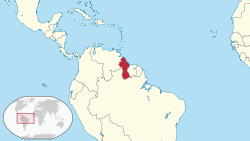Gùyánà
| Àyọkà yìí únfẹ́ ìyílédèdà sí Yorùbá. Ẹ ran Wikipedia lọ́wọ́ ṣàtúnṣe sí ìyílédèdà |
Co-operative Republic of Guyana Orílẹ̀-èdè Olómìnira Aláfọwọ́sowọ́pọ̀ ilẹ̀ Gùyánà | |
|---|---|
Motto: "One people, one nation, one destiny" | |
Orin ìyìn: "Dear Land of Guyana, of Rivers and Plains" | |
 | |
| Olùìlú àti ìlú tótóbijùlọ | Georgetown |
| Àwọn èdè ìṣẹ́ọba | English |
| Lílò regional languages | Guyanese Creole, Portuguese, Spanish, Akawaio, Macushi, Wai-Wai, Arawak, Hindi |
| Àwọn ẹ̀yà ènìyàn | 43.5% East Indian, 30% Black, 17% Mixed, 9% Amerindian |
| Orúkọ aráàlú | Guyanese |
| Ìjọba | Semi-presidential republic |
• Ààrẹ | Irfaan Ali |
| Mark Phillips | |
| Independence | |
• from the United Kingdom | 26 May 1966 |
| Ìtóbi | |
• Total | 214,999 km2 (83,012 sq mi) (84th) |
• Omi (%) | 8.4 |
| Alábùgbé | |
• 2009 estimate | 772,298[1]1 (160th) |
• 2002 census | 751,223[2] |
• Ìdìmọ́ra | 3.5/km2 (9.1/sq mi) (225th) |
| GDP (PPP) | 2008 estimate |
• Total | $3.082 billion[3] |
• Per capita | $4,035[3] |
| GDP (nominal) | 2008 estimate |
• Total | $1.130 billion[3] |
• Per capita | $1,479[3] |
| HDI (2006) | ▲ 0.725[4] Error: Invalid HDI value · 110th |
| Owóníná | Guyanese dollar (GYD) |
| Ibi àkókò | UTC-4 |
| Ojúọ̀nà ọkọ́ | left |
| Àmì tẹlifóònù | 592 |
| ISO 3166 code | GY |
| Internet TLD | .gy |
| |
Gùyánà (![]() /ɡaɪˈænə/ gy-AN-ə),[5] lonibise bi Orílẹ̀-èdè Olómìnira Aláfọwọ́sowọ́pọ̀ ilẹ̀ Gùyánà,[6] je orile-ede alase ni etiomi apaariwa ni Guusu Amerika. Asa re je ko jo awon Eledegeesi Karibeani be sini o je ikan ninu awon orile-ede Karibeani die ti ko je erekusu. Agbajo Karibeani (CARICOM), ti Guyana je omoegbe, ni ibudo isese re ni oluilu Guyana, Georgetown.
/ɡaɪˈænə/ gy-AN-ə),[5] lonibise bi Orílẹ̀-èdè Olómìnira Aláfọwọ́sowọ́pọ̀ ilẹ̀ Gùyánà,[6] je orile-ede alase ni etiomi apaariwa ni Guusu Amerika. Asa re je ko jo awon Eledegeesi Karibeani be sini o je ikan ninu awon orile-ede Karibeani die ti ko je erekusu. Agbajo Karibeani (CARICOM), ti Guyana je omoegbe, ni ibudo isese re ni oluilu Guyana, Georgetown.
Guyana tele je ibiamusin Holandi ati fun ogorun meji odun ti Ileoba Asokan. It is the only state of the Commonwealth of Nations on mainland South America and the only state in South America where English is the official language. Guyana achieved independence from the United Kingdom on 26 May 1966 and became a republic on 23 February 1970. In 2008, the country joined the Union of South American Nations as a founding member.
Historically, the region known as "Guiana" or "Guyana" comprised the large shield landmass north of the Amazon River and east of the Orinoco River known as the "Land of many waters". Historical Guyana consists of three Dutch colonies: Essequibo, Demerara and Berbice. Modern Guyana is bordered by Suriname to the east; by Brazil to the south and southwest; by Venezuela to the west; and by the Atlantic Ocean to the north.
At 215,000 square kilometres (83,000 sq mi), Guyana is the third-smallest independent state on the mainland of South America after Uruguay and Suriname. Its population is approximately 770,000.
Ìtumọ̀ orúkọ[àtúnṣe | àtúnṣe àmìọ̀rọ̀]
Ìtàn[àtúnṣe | àtúnṣe àmìọ̀rọ̀]
Jẹ́ọ́gráfì[àtúnṣe | àtúnṣe àmìọ̀rọ̀]
Òkòwò[àtúnṣe | àtúnṣe àmìọ̀rọ̀]
Irúọmọìlú[àtúnṣe | àtúnṣe àmìọ̀rọ̀]
Ìjọba àti ìṣèlú[àtúnṣe | àtúnṣe àmìọ̀rọ̀]
Ìlera[àtúnṣe | àtúnṣe àmìọ̀rọ̀]
Ẹ̀kọ́[àtúnṣe | àtúnṣe àmìọ̀rọ̀]
Àṣà[àtúnṣe | àtúnṣe àmìọ̀rọ̀]
Eré-ìdárayá[àtúnṣe | àtúnṣe àmìọ̀rọ̀]

|
Àyọkà yìí tàbí apá rẹ̀ únfẹ́ àtúnṣe sí. Ẹ le fẹ̀ jù báyìí lọ tàbí kí ẹ ṣàtúnṣe rẹ̀ lọ́nà tí yíò mu kúnrẹ́rẹ́. Ẹ ran Wikipedia lọ́wọ́ láti fẹ̀ẹ́ jù báyìí lọ. |
Itokasi[àtúnṣe | àtúnṣe àmìọ̀rọ̀]
- ↑ Guyana 2009 Population Estimate Archived 2018-12-23 at the Wayback Machine. CIA World Factbook. Retrieved 25 June 2009
- ↑ Guyana 2002 Census Bureau of Statistics - Guyana. Retrieved 25 June 2009.
- ↑ 3.0 3.1 3.2 3.3 "Guyana". International Monetary Fund. Retrieved 2009-04-22.
- ↑ Guyana HDI The United Nations. Retrieved 25 June 2009.
- ↑ Also pronounced /ɡaɪˈɑːnə/ gy-AH-nə, /ɡiˈænə/, and /ɡiˈɑːnə/.[1]
- ↑ Àṣìṣe ìtọ́kasí: Invalid
<ref>tag; no text was provided for refs namedparliament



